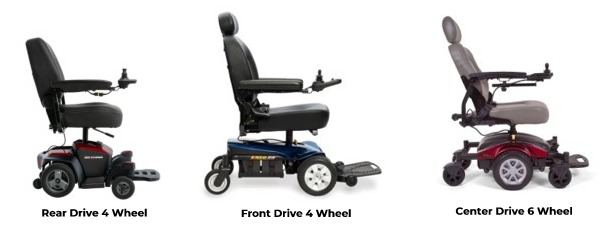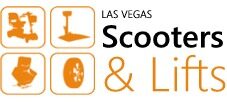<<< Back | Scooters | Power wheelchairs |
Not sure what mobility product you want or need?
What’s the difference between a scooter and a power wheelchair?
There are two types of battery powered mobility devices that help people with walking issues, these are commonly known as mobility scooter and power wheelchairs. Below we will explain some of the main differences between the two types to help you better understand the differences and hopefully choose the right one.
Power Wheelchairs
Power Wheelchairs or powerchairs are basically like a manual wheelchair with motors and a joystick to control the direction of travel. Perfect for someone who needs mobility all-day-long or needs something in the home to get around. A powerchair is perfect for people who have suffered a stroke or amputee where safety is number one and using two hands to operate a scooter steering tiller would not be an option.
Like mobility scooters, powerchairs come in many different variations, wheel configurations, shapes, sizes and options to accommodate different people. Some cases a power wheelchair can be highly modified to suit someone who needs special adaptations to the chair for the user to be comfortable and able to operate it. Typically, this type of power wheelchairs is not usually available for retail purchase due to the expense of modification but can sometimes be found on the secondhand market. We recommend not purchasing something that is highly modified as getting parts for a repair for a highly modified powerchair would be slim to none unless the dealer is licensed to work on these types of powerchairs.
Some Differences you can find on a Power Wheelchair
Wheel and Drive Configurations
Overall Size
Weight Capacity
Battery Options and Sizes
Operating controls
Speed and Range
Chair Options and functions
Wheel and Drive Configurations:
Power chairs have serval wheel and drive combinations and configurations (see below). All powerchairs are driven by two independent motors that control the steering direction by slowing one wheel compared to the other which will cause the chair to steer in a certain direction. Also when a sharper turn is required the controller takes the input from the joystick and reverses the direction of one wheel while the other wheel is in the forward motion give the power chair its great “turn on a dime” feature
Rear Drive 4 Wheel
Typically, most transportable and foldable powerchairs are made in this configuration for transporting and folding reasons. Great for air flight and cruise ships.
Front Drive 4 Wheel
Gives you balanced weight distribution and forward gradient climbing similar to a front wheel drive car. Can be prone to forward tip when going down a slope.
Center Drive 6 Wheel
With its six-wheel point of contact the center drive powerchairs are the most stable of all. Featuring four (2 rear and 2 front) caster wheels this gives the chair the safest ride when out on the sidewalks and ramps. These powerchairs are typically the heaviest and largest of all and can be prone to getting stuck when trying to travers high thresholds.

Size:
Like mobility scooters, power wheelchairs are categorized into the following; Light-Weight and Foldable, Transportable, Full-Size and Heavy Duty. Your size and weight would be a major contributing factor when choosing the size of powerchair.
Typically, smaller transportable (disassemble and foldable) powerchairs suit a smaller, lighter weight person. With these types of powerchairs the pieces are lighter in weight and makes for lifting and transporting in a vehicle easier. Smaller powerchairs like the Go-Chair from Pride tend to be less expensive to purchase than larger full and heavy duty size. They have lower weight capacities, shorter drive range, smaller drive body part components, shorter in width and length which makes for smaller foot plate space.
Weight Capacities:
Smaller powerchairs have weight capacities that are typically between 250 and 300lbs. Weight capacities are not only just for the structural integrity of the scooter, but the drive components and drive ranges are tested and rated for the maximum rated weight capacity. Using a powerchairs that is not rated for your weight will reduce the life of the drive motors and gears and cause damage to the unit. Using a powerchair that isn’t rated for your weight will invalidate any manufactures warranty.
Battery Options: There are mainly two types of batteries used in powerchairs. SLA (Sealed Lead Acid) and GEL AGM deep cycle batteries and also Lithium Ion. SLA and GEL AGM batteries are heavier, have short life spans but are normally cheaper to replace. Lithium Ion tend to be lighter in weight, last approximately a minimum of five years, charge quicker but are more expensive to replace.
Other option you can get for your powerchairs are Extended Range Battery options, Airline Friendly Batteries (lithium Ion) which are governed by FAA regulations.
Joystick handle and Operating Controls
Power wheelchairs are normally operated using an armrest mounted joystick but some powerchairs have the option of being operated by a second person at the rear of the chair, where the user would direct the powerchair by moving the joystick in the required direction of travel. The joystick will feature an on/off button, horn button and also a speed controller either a rotary knob or led lit buttons. Charging your powerchair is typically done via the joystick with what’s called a XLR port which is industry standard on all scooters and powerchairs (see your owner’s manual for your specific location). A charge port is typically located under the joystick for easy access. The joystick can be used like a gas pedal in a car to increase and decrease the forward or reverse movement of the powerchair. The joystick placement can also be changed from right to left depending on the operators’ preferences. Some joysticks have alterable settings programmed into them that control many parameters such as forward, reverse and turning speed plus many other settings. These setting can be adjusted by a wheelchair technician using the appropriate programming unit. (please see your local dear for more information)
Speed and Range
Smaller powerchairs tend to have a lower maximum top speed of around 3.5 mph whereas mid-size, large, heavy duty and recreational power chairs can have a higher top speed depending on brand. Range of travel depends on several factors but larger and heavy duty powerchairs have longer drive ranges due to their larger battery capacity. Other factors that can reduce drive range are age of the device, type of terrain (inclines), heat, speed and age of batteries. Most manufactures give a drive range with an average weight person on flat level ground. The manufactures drive range can also be affected by the age of the unit due to wear and tear.
